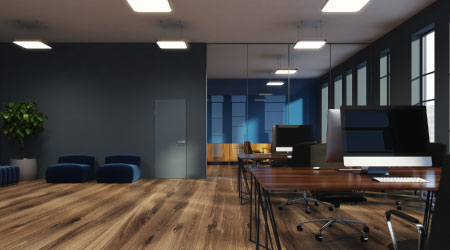Natural Products Emerge as Popular Floor Covering Option
Cork, rubber, bamboo, linoleum and wood fall into this category of flooring products. Three of these products are wood-type flooring or contain wood materials.
Hardwood is cut entirely from a particular tree, such as oak, cherry or mahogany. Engineered wood has a face of a particular type of wood, but beneath that is layered, in opposing directions, wood material that provides stability. Hardwood has a tendency to react more with changes in environmental or substrate conditions and should only be used above grade. Engineered wood is more dimensionally stable and can be used below grade.
One important fact to remember about wood is that it is a tree cut into flooring material. As a result, it will do the same things on the floor that a tree does in a forest — gain and lose moisture, expand, contract, crack, warp, distort, dent and scratch, regardless of the finish. These characteristics are not a bad thing, just natural. So managers who want to install wood floors must understand they will be subject to these conditions, which might limit its applications.
Bamboo is actually grass, not wood. Most bamboo comes from China and Asia, and the manufacturing process and quality can vary. The performance levels also can vary, and the material can have a low or high hardness rating. Managers must be sure to know the product being specified and its past applications in similar situations.
Cork is the bark of a tree. It is great product, but if it is not installed properly, planar issues — lying flat — can arise. Installing cork is a very specific process, and if it is not installed properly by experienced mechanics, it will curl on the edges.
Linoleum contains cork dust, wood flour, linseed oil, and fillers, which are often calcium carbonate found in rocks of all kinds. Linoleum today uses woven polyester backing for burlap. Linseed oil oxidizes, causing the material to change color, and it can be sensitive to atmospheric conditions. Matching a replaced tile, even with attic stock, can be nearly impossible. Polyester backing can be embossed onto the face of the flooring tiles when packaged. This product also might curl on the floor and should be installed by manufacturer-trained installers.
Rubber has gained in popularity, especially in health care facilities, schools and, in thicker variants, sports and gym flooring. Rubber flooring is a high-performance material that, in most cases, delivers excellent performance. It is important that managers buy from manufacturers with long and solid reputations. Rubber flooring also should be installed by manufacturer-trained mechanics.
Whatever flooring type managers choose, they need to take into account sustainability claims of manufacturers. Just because a product might be green, managers have to understand the material's contents and the way it will perform once installed. Do not get caught up in sales hype or environmental conscientiousness when the product actually might create headaches and more costs.
This is not to say managers should not specify natural products. But they must know what products to use, how and where to install them, and a product's natural characteristics that might have unforeseen and costly consequences.
Related Topics:














